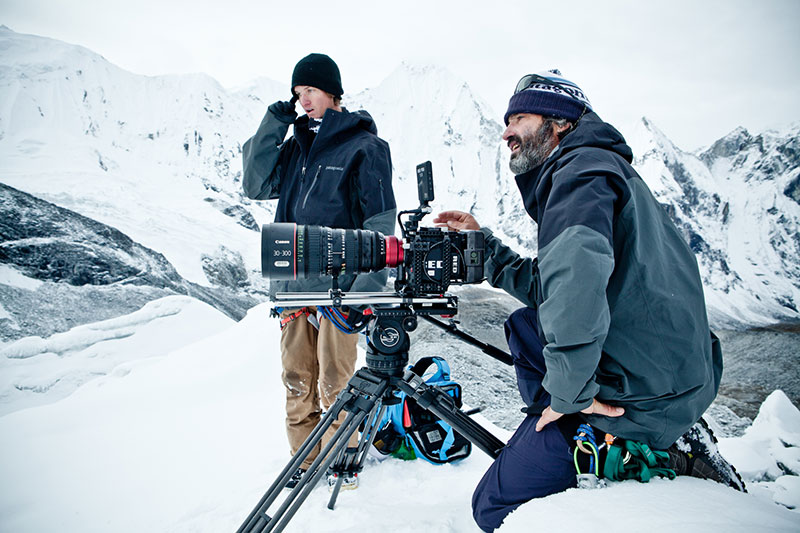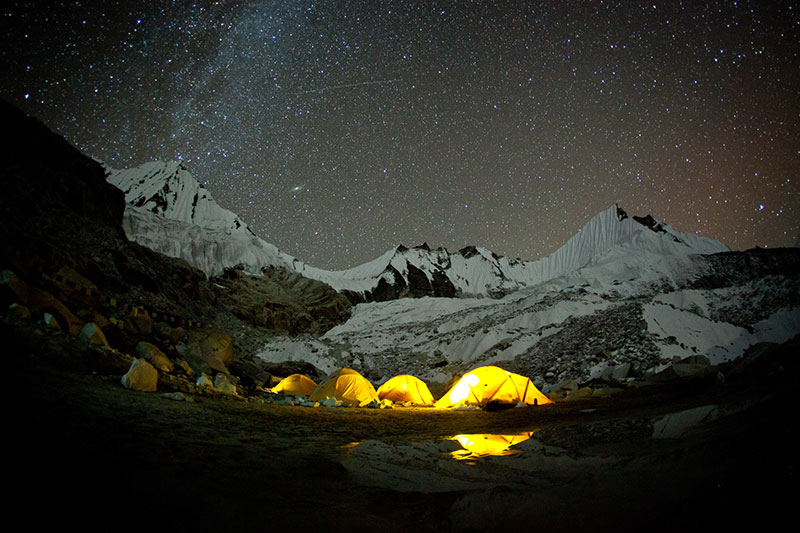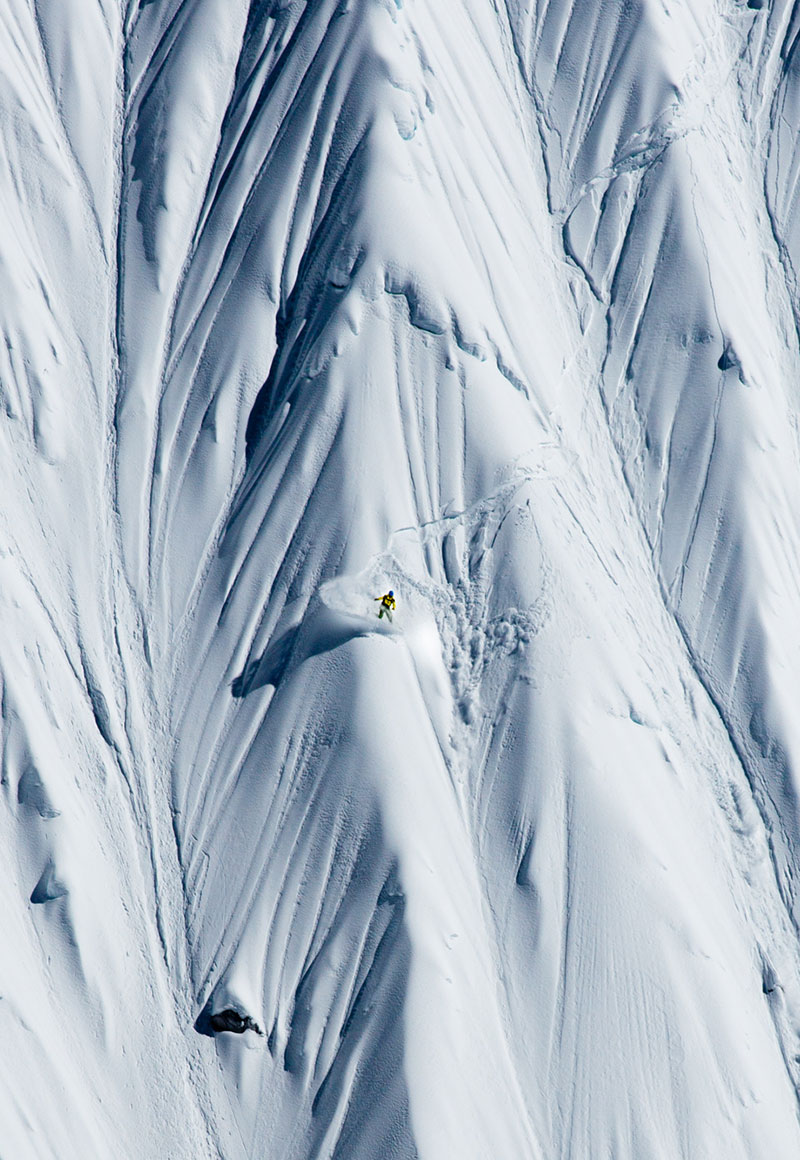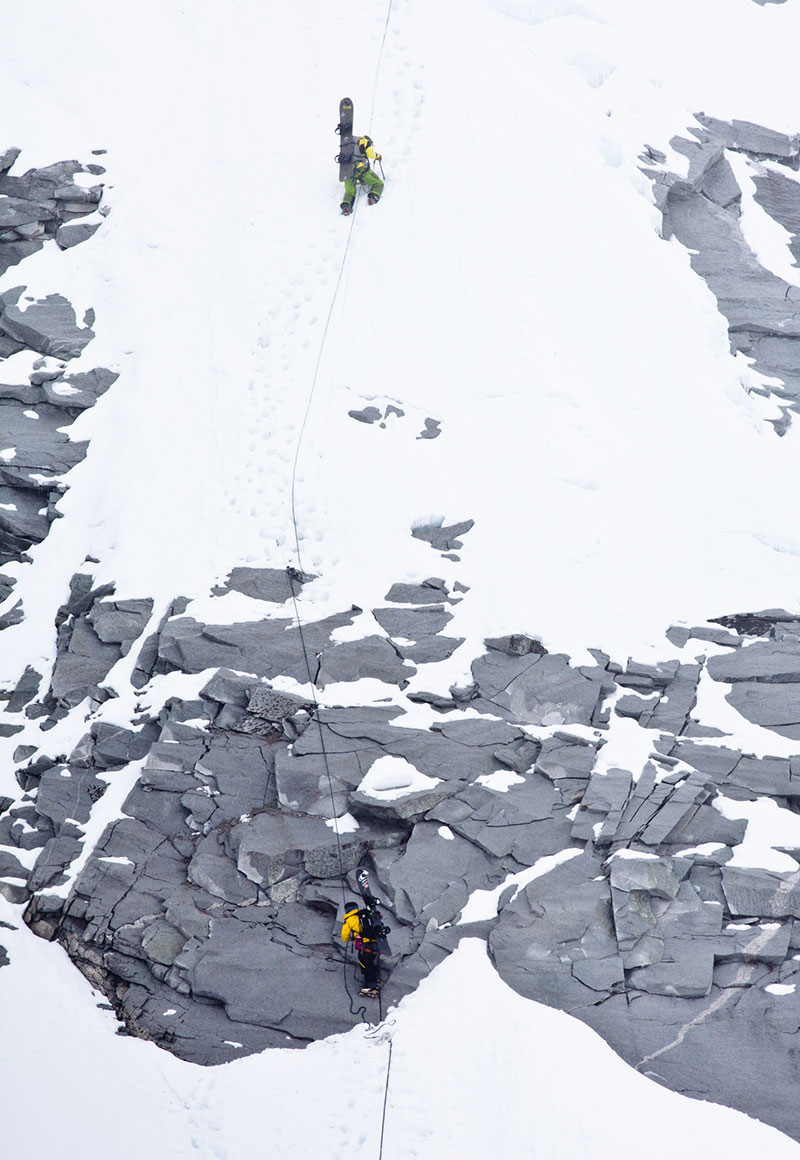Riding High: Jeremy Jones In Nepal
It’s a commonly held belief amongst snowboarders that the ultimate test will always be Alaska.
Speak to any climber and they’ll tell you otherwise.
The Himalayas are higher, steeper and gnarlier than any other range on the planet. They are the world’s third largest deposit of ice and snow, after Antarctica and the Arctic. And they are shrouded in mountaineering legend, from Hillary and Tenzing’s conquest of Everest in 1953 to the numerous doomed attempts on that other notorious peak, K2. On top of all this, the Himalayas (literally, “Abode of Snow”) are home to the fascinating local cultures of Nepal and Tibet.
And yet, they remain in many ways the forgotten range for the freeride community. While powder hounds – both skiers and snowboarders – regularly chase new lines in Europe, Japan, South America, the former Soviet Union and, yes, Alaska, few crews have ever mounted expeditions to the so-called Roof of the World. In the hunt for extreme descents, then, the Himalayas are the elephant in the room.
The truth is that they are just too damn difficult, too damn dangerous and too damn expensive to access. Witness what happened in 2007, when WL last reported on a major film trip to Nepal – Rip Curl’s ill-advised attempt to build a kicker at over four and a half thousand metres:
“It is clear that the mission has been a total failure,” recorded team photographer Eric Bergeri in his diary. “We could not build a kicker; we couldn’t even stick a shovel in that packed snow. Weather, snow conditions and timing were against us. All of that, plus the massive avalanches that continually fall around us, are like a lesson from nature. Us western people are too used to paying for whatever we want, but the message is clear: our lives are worth nothing; Nature is almighty.”
it was time to write a final chapter in the trilogy of films that has seen him go Deeper and Further in a perilous tango with gravity. It was time to go Higher.
Given this intimidating background, it’s hardly surprising that Himalayan challenges are usually undertaken by experienced mountain men – the average age of an Everest lead climber, for instance, is 38.
And so, for snowboarding’s latest venture into thin air, enter Mr. Jeremy Jones. With two decades of backcountry riding behind him, including more firsts than an Oxbridge graduation ceremony, it was time to write a final chapter in the trilogy of films that has seen him go Deeper and Further in a perilous tango with gravity. It was time to go Higher.
This particular mission began with a text message. Jeremy had been on the lookout for a suitable high altitude peak when one of the film crew sent him a picture of a mountain he’d stumbled upon in a library book about Himalayan culture. It was a towering, unnamed ridge some 21,000 feet high, from which a series of precipitous powder spines tumbled down like a bewitching, half-open fan.
Further research placed the mystery crag – now re-christened “The Shangri-La Spine Wall” – near a popular climbing route, though as far as they could tell no one had scaled it. After two months of planning Jones set out to be the first person to reach the summit… and snowboard back down.
The locals thought it was impossible. Jeremy himself could not be sure he would succeed in the thin air where so many other folk had met their match. The following is the story of that trip, in his own words.
DAY 2 - Getting off the plane in Kathmandu, it was immediately clear I was in a different world. Monkeys hanging from power lines, families weaving through six-lane traffic on scooters, yaks in the middle of the street and people everywhere. Here we are at the Monkey Temple, harnessing as much positive juju as we can for the mission ahead.
DAY 3 – What I love about travel is you never know what you’re going to see. Meeting different people along the way and seeing how they live gives your own life some welcome perspective. I was talking to these medicine men on the banks of a river and watching cremation ceremonies being performed in the middle of a bustling town.
DAY 4 – Flying into Lukla (the starting point for most Everest missions) was a trip. We were stuffed into this small plane that had been put into retirement long ago back in the first world. We all had our expedition backpacks on our laps. For the 40-minute duration we were weaving in and out of clouds and threading our way between peaks. Suddenly, the shortest airstrip I have ever seen appeared. It was tacked onto the side of a mountain and was actually slanted uphill. It was a relief to walk off in one piece.
DAY 8 – Before coming to Nepal I thought I lived in the mountains; once here, I realized I live in the foothills. These people live in the mountains. For days we trekked our way up the Khumbu Valley. Hours would go by without seeing anything, and I would sense we were leaving civilization behind – only to come around a corner and see a town stapled to the side of the mountain. Almost all the inhabitants’ supplies come in on foot. They lead a simple, rustic life and are some of the happiest people on earth. Ironically, most of them told us they really want to come to the US.
DAY 12 – We are heading into Base Camp, with Everest and Lhotse in the background. Excitement is at an all time high. It’s time to get off the trail and into the heart of the Himalayas.
The porters are a physical anomaly. A normal load for these guys is a hundred pounds (about 45 kilos) attached via some twine and a piece of tarp that goes around their forehead. Some of the guys were carrying double loads – 200 pounds! At 5’8″ I would be considered big there. I have no idea how they do it.
DAY 14 – Carrying a load to High Camp for the first time, up around 17,000 feet. Sir Edmund Hillary set a camp up here in the ’50s. My eyes are glued to the direction of the face in hopes of getting a glimpse of it. Is it rideable? Am I crazy for travelling to the other side of the world to try to snowboard in Nepal?
DAY 17 – An early morning break in the clouds after an evening snowstorm. I could never really wrap my head around these mountains. The size, magnitude, and vastness are on a level I have never seen before.
DAY 21 – Going into this trip I got very little encouragement from most climbers about the chances of finding good snow – but then, climbers tend to come in the dry season and focus on higher mountains. On the advice of mountaineers Conrad Anker and Jon Krakauer, we aimed for the end of the monsoon season, when they believed there would be fresh powder on peaks below 23,000 feet. And they were right. There was a lot of potential for significant descents in the 18k to 23k zone. I have no idea if we got lucky with conditions, if they were average, or if it was actually a bad year, but it looks to me like there are a lot of unclimbed and unridden dream lines just waiting for an ambitious rider to tackle them.

DAY 27 – Working on the last two films with Teton Gravity Research has been a huge learning experience, both in how I climb the mountains and how we document it. The cameramen are the true unsung heroes of the films. They have to carry tons of weight, sleep with batteries and keep their lenses from fogging up during multi-day storms. For Higher, TGR wanted to step it up and shoot it in 4K resolution. I was not sure if this was possible due to the added weight of the cameras, but the crew embraced the challenge. Here Matt Herriger dials in the long lens while Nick Kalisz looks on. These guys are the best in the world at what they do.

DAY 29 – Base Camp. No one has camping more dialled than the Nepali people. I left all the logistics to our local handler in Nepal, Jiban Ghimire. We never talked about our base camp setup, food or any other details. I could not believe my eyes when I came over the ridge and saw base camp for the first time. We had a dining tent, cook tent, media tent, shower tent and bathroom tent. They said this was their basic level of camp accommodation.
DAY 29 – Back at Base Camp waiting out a storm. A good crew is key to the success of any expedition. Having the right skill set is important, of course, but a positive attitude is equally essential – especially during the inevitable low points. There are plenty of people that can stay positive for the first two weeks of a trip, but not many can maintain high spirits through weeks 3 or 4.

DAY 30 – Picking a riding partner for this trip was tricky. I was looking for someone with Himalayan experience, who could handle really steep terrain and who had been on long expeditions before. These criteria quickly whittled it down to Luca Pandolfi from Chamonix. He had been to Pakistan in the past and racked up some of the most impressive big mountain descents in the Alps over the last few years. Here he’s enjoying some good snow on one of our first laps of Shangri-La.
DAY 32 – The day before this, I sat for three hours at 21,400 ft on the top of Shangri La (the white peak on the right skyline), waiting for a cloud to move off the face. At 3.30pm I aborted the mission and down climbed the ridge in a whiteout to the saddle, from where I could ride the rest of the way. It was the hardest day of the trip and spirits where at an all time low as we walked back into High Camp at 9pm that night. We were all spent and thinking of heading back to Base Camp for a much needed rest day at lower altitude, but news of a huge monsoon approaching in the next 36 hours changed our plans.

We stayed put and made one more attempt for the peak. As forecasted, a 10-day storm came in the day after we rode the face and dropped 8 to 10 feet of snow in the mountains.
DAY 33 - Dropping in off the top of the line, the snow was a little firm for the steepness of the face. At 45 degrees it would have ridden really well, but at 60 degrees I was having a hard time holding an edge. At this point I’m almost needing to rope descend, with my axe in the snow. The line was relentless. Normally halfway down a face the slope starts to flatten out, but with this one it actually got a few degrees steeper.
DAY 33 – I have made it past the crux and into better snow. I am no longer in a “no fall” zone but am physically spent. I was really surprised how hard the riding was at altitude. A few months prior to this trip I snowboarded off Denali (Mt McKinley) and felt pretty good, but this was much more demanding riding and every turn required an explosive movement. It felt like snowboarding underwater. All I can compare it to is the worst hold-downs I’ve ever had surfing, where I would come up seeing black spots. Never have I maxed out my lungs like that.
Every turn required an explosive movement. It felt like snowboarding underwater
DAY 35 – Sitting in Lukla airport, waiting out a three day monsoon rain spell as we tried to get home, gave us the chance to process everything that had happened in the past month. I still can’t believe we came halfway across the world to ride a face we found pictured in a climbing book. Many up and downs were had, everybody was pushed to their limits, but somehow the Goddess of the Himalayas decided she would let us struggling humans get a small taste of that incredible spine wall. It was a true ‘trip of a lifetime’, in which the journey itself had proved the reward. I think all of us found our own Shangri-La in those majestic mountains.
